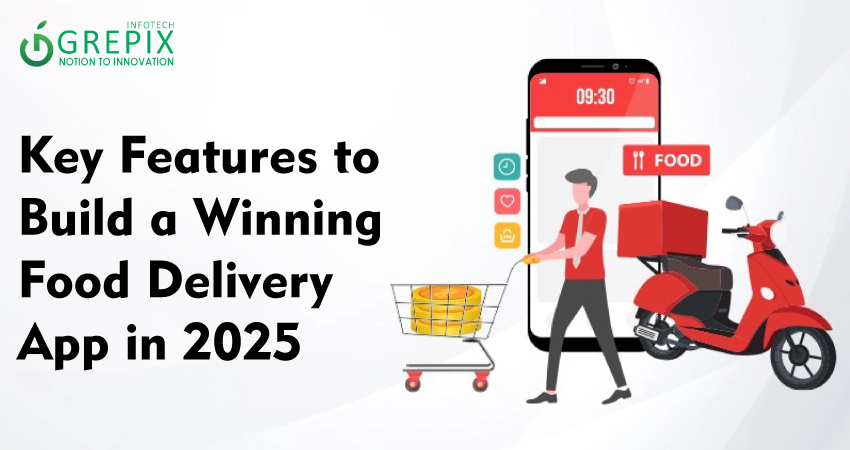Key Features to Build a Winning Food Delivery App in 2025
The food delivery market has evolved dramatically, with fierce competition demanding not just functional, but superior, future-ready platforms. For entrepreneurs, restaurants, and software developers, understanding and implementing the right “food delivery app features” can turn a promising idea into a market leader. What distinguishes a must-have food delivery app in 2025? This guide breaks down the best features, successful strategies, and future trends, backed by industry examples and current statistics.
The landscape of food delivery apps in 2025 is driven by technology, user experience, and operational efficiency. Winning platforms integrate advanced search, real-time tracking, cloud kitchen support, personalized marketing, and AI-powered features for consumers, restaurants, and delivery partners. With the right balance of functionality and innovation, your software can stand out in a fast-growing, trillion dollar global market. This guide provides essential insights, actionable steps, and expert FAQs to help you build and launch a successful food delivery app.
Core User Features: What Every Winning Food App Needs
Delivering frictionless ordering experiences is crucial. The following are non-negotiable “must-have food delivery app” features for user engagement:
User-Friendly Interface
A seamless, intuitive interface keeps users coming back. Minimal clicks, easy navigation, clearly labeled icons, and color-coded menus matter. For example, Uber Eats leverages a familiar layout and quick search to reduce friction and expedite ordering for millions globally.
Advanced Search & Smart Filters
Give users control with dynamic filters by cuisine, diet, delivery time, budget, and location. AI-driven recommendations are now expected; DoorDash uses purchase history for personalized menus, boosting repeat orders by 20%.
Real-Time Order Tracking
Live GPS tracking, status notifications, and estimated time of arrival are standard. Swiggy turned real-time tracking into a trust-building tool, raising order volume and retention.
Multiple Secure Payment Methods
Support cards, wallets, UPI, and emerging pay-later options. Reliability and security boost conversion rates, especially when paired with easy refunds and 24/7 chatbot support.
Favorites & Quick Reorder
Allow users to save favorite dishes or restaurants, accelerating future orders and increasing lifetime value.
Order History & Smart Recommendations
Order history lets users plan, reorder, and budget efficiently. Smart suggestions based on previous orders save time and encourage upsells, as seen in Zomato’s pivot from discovery to delivery.
Push Notifications & Alerts
Useful notifications build engagement: update on order status, promotions, loyalty points, and exclusive offers. AI personalizes timing and content for higher open rates.
Seamless Registration and Profile Management
Fast onboarding with social logins, phone/email, and simple profile management is essential. This lowers abandonment rates and drives sign-ups.
Real-Life Example
Uber Eats successfully leveraged their existing rideshare app users, offering seamless cross-app integration and payment processes, resulting in rapid adoption and trust.
Restaurant Features: Empowering Partners for Growth
Winning food delivery software features go beyond the consumer they empower restaurants to succeed and scale.
Menu Management Dashboard
Enable restaurant partners to easily update dishes, prices, deals, and daily specials. Efficient dashboards, like those in Zomato and Deliveroo, facilitate quick adjustments and keep menus fresh.
Inventory Automation
AI-driven inventory management predicts demand, automates reordering, and reduces waste. McDonald’s uses machine learning to optimize ingredient stock, lowering costs and improving consistency.
In-App Promotions & Loyalty Programs
Create customized loyalty programs and discount campaigns. Deliveroo’s premium positioning leverages exclusive deals with select restaurants, driving higher-margin orders.
Analytics & Insights
Offer dashboards with real-time metrics active users, top sellers, revenue, ratings, and reviews enabling smart, data-driven decisions. This insight is key for optimizing menus, pricing, and staffing.
Review and Reputation Management
A restaurant portal for managing reviews and ratings helps address customer concerns quickly and maintain high standards. Just Eat prioritized local restaurant relationships and reputation building to trust and retention.
Cloud Kitchen Integration
Support for virtual cloud kitchens allows restaurants to operate delivery-only brands, expand reach, and reduce overhead. Deliveroo Editions is a case in point, serving multiple brands from one location with tailored menus.
Case Study Highlight
Deliveroo grew rapidly through selective restaurant partnerships, high-end packaging, and consistent, premium service charging higher fees but delivering higher quality.
Delivery Partner Features: Boosting Efficiency and Satisfaction
Delivery partners are the engine of any must-have food delivery app. Investing in functionality for drivers enhances service and retention.
Optimized Route Planning
AI-powered logistics find the fastest delivery path, cutting costs and improving delivery times. GPS and real-time traffic help drivers deliver hot, fresh meals, a strategy that made DoorDash a top performer.
Earnings Tracker and Flexible Scheduling
An earnings dashboard showing completed orders, bonuses, tips, and flexible scheduling options is crucial for driver loyalty.
In-App Chat & Alerts
Secure messaging between drivers, restaurants, and customers eliminates confusion, speeds up issue resolution, and ensures smooth service.
Ratings and Feedback
Allow customers to rate drivers and for drivers to rate support interactions; this motivates excellence and quickly flags areas needing improvement.
Contactless Delivery
Post-pandemic, users expect contactless delivery options and instructions. Integration with smart lockers or delivery pods offers added safety and convenience.
Real-Life Example
Swiggy Genie and Swiggy Instamart expanded the standard delivery model, creating auxiliary services for diverse deliveries from groceries to late-night errands boosting driver earnings and platform engagement.
Admin Features: Control, Monitor, and Scale
The best food delivery software features include robust admin panels for monitoring, scaling, and compliance.
Centralized Control Panel
Track active users, real-time orders, revenue charts, top restaurants, and fleet performance. AI-driven dashboards provide actionable analytics, enabling real-time troubleshooting and strategy planning.
Order & Dispute Management
Automate order assignment, resolve disputes, process refunds, and manage chargebacks. AI streamlines these tasks, reducing manual errors and customer dissatisfaction.
Multi-Level Permissions & User Management
Assign varying access levels for support teams, managers, and marketing staff. Secure, role-based controls are essential for operational efficiency.
Payment and Revenue Management
Automate payouts to restaurants, delivery partners, and merchants with support for multiple currencies and compliance tracking.
Marketing & CRM Tools
Sophisticated marketing tools allow targeted campaigns, push notifications, loyalty programs, and feedback solicitation, all driving higher retention and lifetime value.
Future-Ready Features: Leading Trends for 2025
Staying ahead means adopting trends shaping winning food apps in 2025.
Voice-Enabled Ordering
Hands-free ordering powered by Google Assistant, Alexa, or Siri makes apps more accessible and convenient, especially for multitaskers and those needing accessibility.
AR/VR Menu Previews
Immersive menu previews let users “see” food in 3D before ordering, reducing dissatisfaction and boosting engagement a trend pioneered by Domino’s and Kabaq.
Predictive AI Ordering
As AI and machine learning analyze past orders, the app “knows” what users want before they search, enabling instant suggestions and rapid repeat orders. Swiggy has increased repeat orders by leveraging this predictive capacity.
Dynamic Pricing
Surge pricing based on demand, weather, and local events keeps supply and demand balanced and rewards partners during peak hours. Uber Eats employs dynamic pricing to maximize efficiency and revenue.
IoT-Enabled Delivery Bag Sensors
Temperature and freshness sensors already adopted by Uber Eats maintain food quality from kitchen to doorstep, building trust and reducing waste.
Gamification & Personalized Loyalty
Badges, reward points, and spend-to-win contests increase engagement. Tailored rewards create emotional investment and long-term retention, demonstrated by Starbucks Rewards.
Sustainability and Green Options
Eco-friendly delivery methods bike fleets, electric scooters, and recyclable packaging are becoming winning food app features for eco-conscious users. These options often boost PR while lowering costs, especially in urban markets.
Drone and Autonomous Vehicle Delivery
While still experimental, drones and self-driving vehicles are no longer science fiction. Companies adopting these future-ready food delivery app features will lead in speed and efficiency, as pilot programs gain traction.
Conclusion
Building a winning food app in 2025 demands blending core usability, restaurant empowerment, delivery partner support, intelligent admin controls, and cutting-edge, future-ready features. Case studies show that strategies like smart partnerships (DoorDash), seamless integration (Uber Eats), local-first approaches (Just Eat), and premium positioning (Deliveroo) are the hallmarks of durable market leaders. Successful platforms solve real problems, invest in technology that actually helps, and cater to the needs of all user types. By focusing on best-in-class software features, collaboration, and innovation, builders can craft apps that not only delight users but also scale and win market share.
FAQs
1. What are the best food delivery app features in 2025?
Modern apps integrate advanced search, AI-powered recommendations, real-time tracking, cloud kitchen support, contactless delivery, voice ordering, and immersive AR/VR menus.
2. How do winning food apps retain users?
Personalized loyalty programs, gamified rewards, predictive ordering, fast issue resolution, and superior user experience drive repeat orders and trust.
3. How much does food delivery app development cost in 2025?
Basic platforms start from $20K; advanced, AI-rich apps may exceed $100K, depending on scale, design complexity, and backend integrations
4. Do food delivery apps support cloud kitchens?
Yes, cloud kitchen integration allows restaurants to operate delivery-only brands and expand reach with lower costs, now a standard winning food app feature.
5. What are real-life success strategies from top food delivery apps?
DoorDash succeeded by targeting untapped markets and building restaurant relationships; Uber Eats leveraged ride-sharing users; Deliveroo focused on premium quality; Just Eat became local-first for global success.







